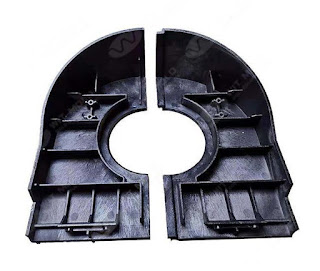As a growing branch of the plastic industry, plastic injection molding is the most commonly used process in the production of plastic parts. Plastic injection molding process is fast, aiming at mass production of the same plastic product in a short time. In the plastic industry, it is used to manufacture a variety of items, such as car bumpers, wheeled dustbins, bottle caps, spools, toys, musical instruments, auto parts, remote controls, electronic products, chairs, mechanical parts, storage containers and medical equipment
What is injection molding?
Injection moulding is a manufacturing process for producing parts by injecting molten material into a mould, or mold. Injection moulding can be performed with a host of materials mainly including metals (for which the process is called die-casting), glasses, elastomers, confections, and most commonly thermoplastic and thermosetting polymers. Material for the part is fed into a heated barrel, mixed (using a helical screw), and injected into a mould cavity, where it cools and hardens to the configuration of the cavity. After a product is designed, usually by an industrial designer or an engineer, moulds are made by a mould-maker (or toolmaker) from metal, usually either steel or aluminium, and precision-machined to form the features of the desired part. Injection moulding is widely used for manufacturing a variety of parts, from the smallest components to entire body panels of cars. Advances in 3D printing technology, using photopolymers that do not melt during the injection moulding of some lower-temperature thermoplastics, can be used for some simple injection moulds.
Injection molding uses a special machine, which is composed of injection unit, mold and fixture. Parts to be injection molded must be designed very carefully to facilitate the molding process; The material used for the part, the required shape and characteristics of the part, the material of the die and the characteristics of the forming machine must be taken into account. This wide range of design considerations and possibilities promotes the versatility of injection molding.
How does injection molding work?
Although the injection molding process is complex, it can actually be broken down into several basic steps to help understand how it works and why it is so effective.
The injection molding machine is composed of three main parts: feed hopper, screw and heating barrel. The working principle of the machine is to take plastic powder or particles and operate them according to requirements and dimensions to form them into parts.
When the feed hopper receives plastic particles, it will use the friction of the screw to generate heat. Once the plastic reaches the correct temperature, it is injected into the mold cavity, where it finally cools and forms according to the mold design.
If necessary, parts can be manufactured from a variety of materials using advanced injection molding technology (e.g. repeated injection). You can also use insert molding to add plastic parts to existing parts made of other materials.
The basic principle behind the injection molding process seems simple, but in fact, it is a very complex process, requiring appropriate equipment and appropriate expertise. However, if implemented properly, injection molding can consistently produce excellent results even for the most challenging manufacturing projects.
Step by step procedure
In the pretreatment stage, the design, shape, color and quality of plastic products must be planned. Injection molding companies determine the type of plastic they will use to produce.
1. Mold setting
In the initial step, the parts are arranged by robot or hand. The two halves of the mold first need to be carefully closed by the clamping part. Hydraulic press is used for clamping.
2. Plastic extrusion
The second step involves the melting of small plastic particles as raw plastic. They were evicted from a very hot room. Extrusion is done with the help of screw tools. Due to the flow change of molten plastic placed in the mold, it is necessary to accurately estimate the injection time.
3. Forming process
Plastic molding means providing the desired shape. The melted plastic is now injected into the mold. The temperature shall be controlled as required.
The forming process is very complex. The whole process must be carried out carefully and pay attention to the pressure of the die clamp. Only experienced manufacturers can operate the injection molding machine effectively without causing any harm. Incorrect timing and management can damage plastic parts.
4. Cooling and demoulding of parts
The plastic part is kept in the mold until it cools and becomes the desired solid shape. During the cooling phase, the plastic may shrink a little. When the required cooling time is over, the half mold can be opened.
The cooling time estimate depends on the material properties of the plastics used in the process. The solid part is then ejected by compressed air or mechanically. Mechanical and mechanical forces are applied when the part is removed from the mold. This is how plastic injection molding works. This process can quickly produce millions of the best quality parts.
5. Post processing
Runner is a channel used to fill the mold cavity and is automatically removed from the part. Finally, finish the product for final use. The flash part is trimmed from the plastic product by using a knife.
The cycle time is processed in seconds. It has produced a mass application of more than 5000 parts. The delivery time of injection molding is 2 to 4 months. The final parts are then counted and weighted. Then the plastic products are transported to different areas.
In A Nut Shell,Plastic injection molding works as the best equipment to design unique and high-quality parts at an efficient speed. It gives flexibility to plastic manufactures to make durable and complex shape products at very cost-friendly rates.


没有评论:
发表评论